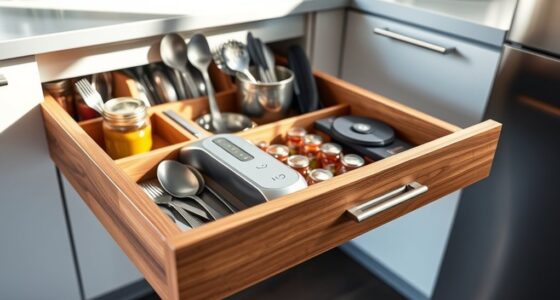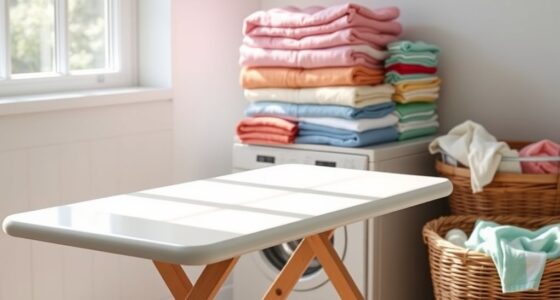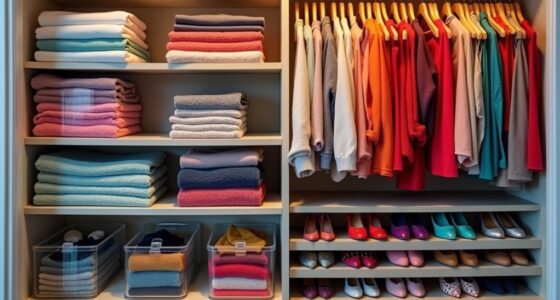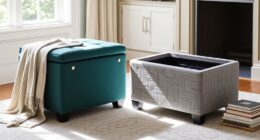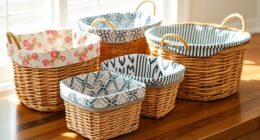If you're drowning in toy chaos, a clear plastic bin organizer under $15 is your best friend. These affordable storage solutions help you categorize toys, making play areas tidy and manageable. Label each bin so kids can easily find and put away their toys. Stackable storage cubes and over-the-door organizers can also maximize space without breaking the bank. Discover how to keep toys organized and more tips for maintaining a clutter-free environment.
Key Takeaways
- Clear plastic bins with labels help categorize and organize toys, making it easy for children to find and return items.
- Stackable storage cubes offer customizable solutions for toy storage, maximizing vertical space while remaining budget-friendly.
- Over-the-door shoe organizers utilize vertical space effectively to store smaller toys, keeping them easily accessible and organized.
- Fabric storage baskets provide a stylish and functional way to contain toys while adding a decorative touch to any room.
- Repurposing dish racks can effectively organize books and puzzles, providing a practical solution for managing toy clutter.
Understanding Toy Clutter
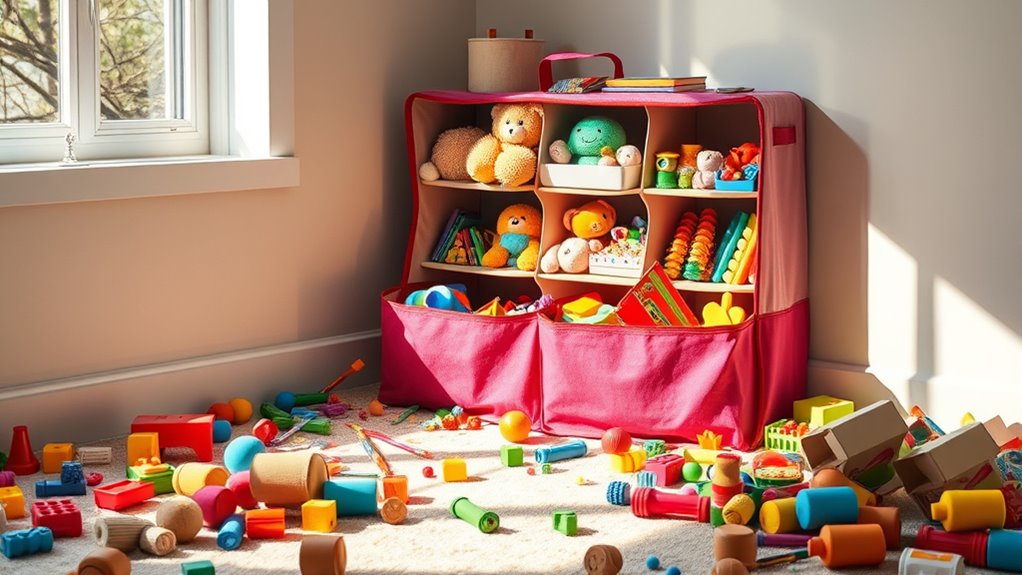
How can you tell if toy clutter is overwhelming your home? If you find it hard to walk through rooms or see toys strewn everywhere, it's time to take action.
A professional organizer can help you tackle this chaos effectively. Make sure to observe your children's play patterns; identifying which toys they actively value can guide you in deciding what to keep and what to let go.
Engaging your kids in the decluttering process fosters responsibility and helps them understand the value of their toys. Consider implementing annual toy decluttering sessions together, focusing on donations rather than disposal. Additionally, utilizing best lifestyle planners can aid in organizing toy spaces and maintaining order throughout the year.
The One in Five Out Method Explained
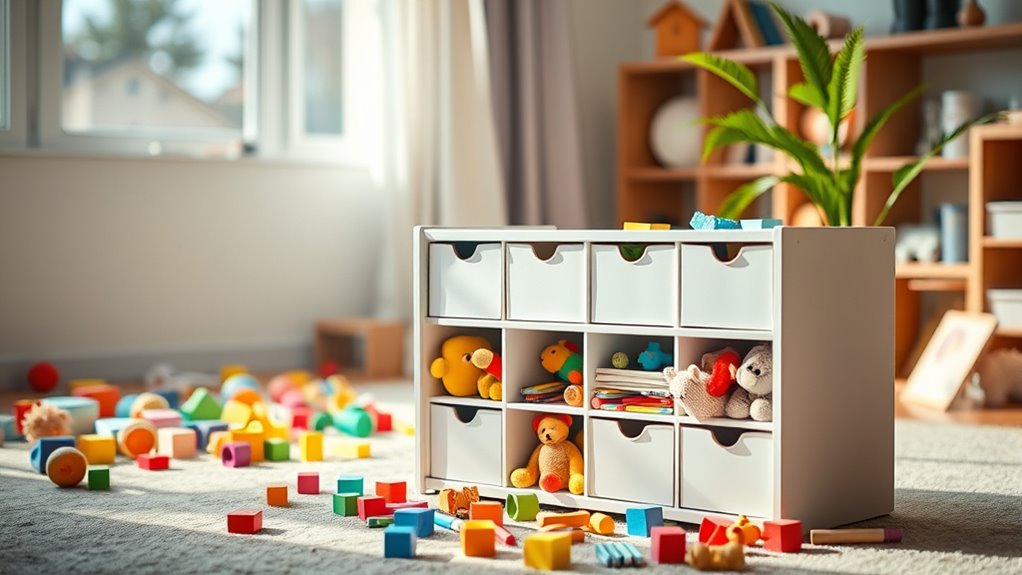
To effectively manage toy clutter, the "One in Five Out" method offers a practical and engaging solution. This strategy requires that for every new toy you bring into your home, you're going to remove five old toys.
It's really easy to implement, and it encourages your children to actively participate in toy management. By helping them evaluate which toys they no longer use or value, you foster a sense of responsibility and decision-making.
Discussing toy retention with your kids can make the process smoother, providing examples of how to let go of toys that don't spark joy anymore. Ultimately, this method leads to a more organized play space filled with toys that truly interest your children.
Effective Quarterly Toy Management
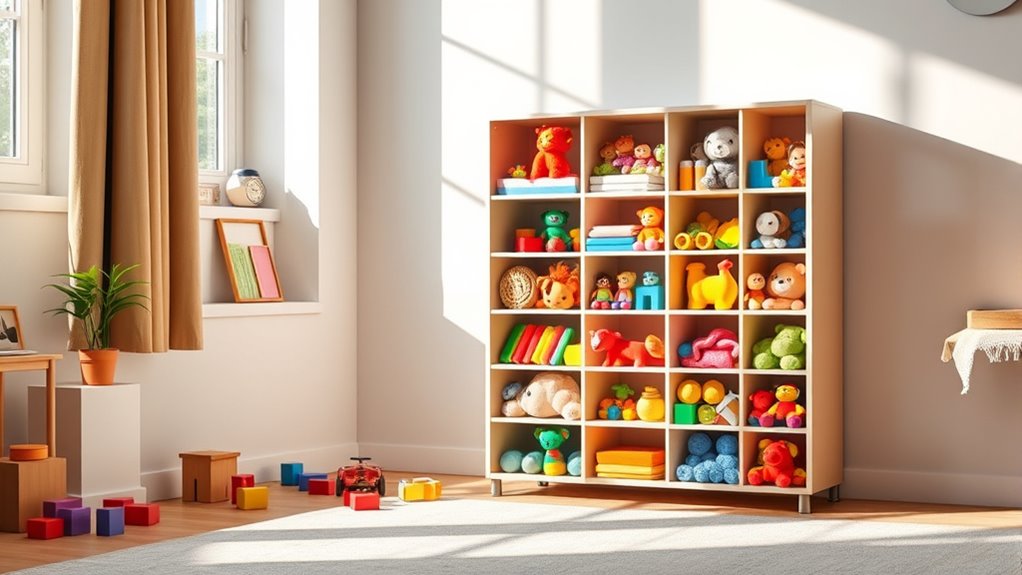
Have you considered the benefits of implementing effective quarterly toy management? Limiting new toy acquisitions to four items each quarter helps keep your space clutter-free.
By observing your child's play patterns, you can identify which toys they genuinely value and which ones can be removed. Rotating toys every few months not only refreshes their interest but also effectively manages the number of toys available at any time.
Regular toy assessments during these quarterly sessions encourage your child to participate in decluttering, fostering a sense of ownership. Plus, removing toys that aren't played with reduces distractions, allowing your child to focus better on the toys they truly enjoy. This method creates a more organized and engaging play environment, while also promoting independence and self-discovery in their play experiences.
Annual Toy Decluttering Strategies

When it comes to managing toy clutter, annual decluttering strategies can turn a challenging task into a rewarding family tradition. Involve your kids in reviewing their toys, encouraging them to identify items they no longer play with. This helps them feel responsible and aware of their choices.
Aim to donate at least 20% of the toys, promoting generosity and teaching the importance of sharing with those in need. Create a checklist to guarantee you cover all categories—broken toys, duplicates, and those that have outlived their usefulness.
Communicating With Gift Givers
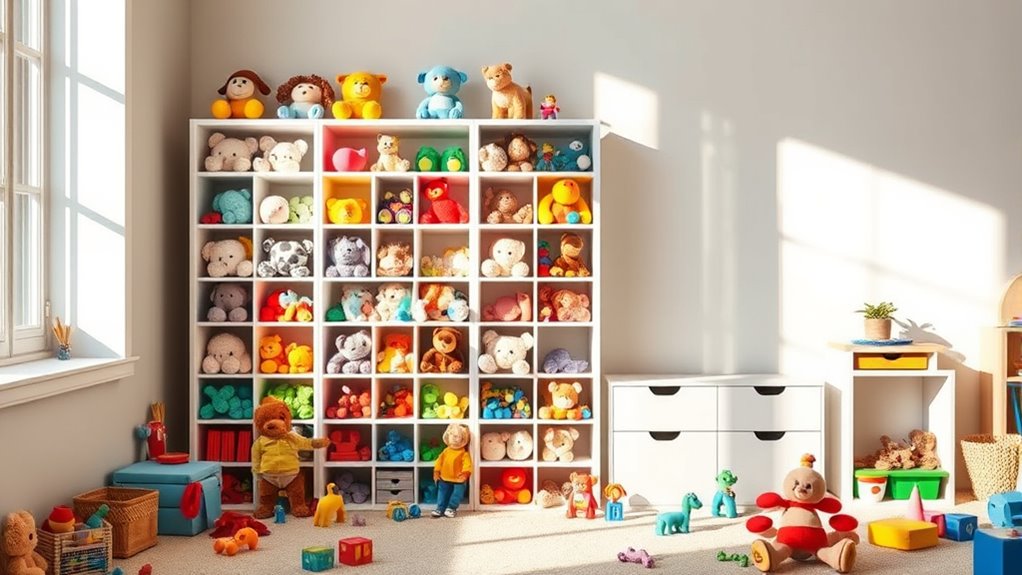
How can you effectively communicate your toy preferences to family and friends? Start by openly discussing your child's interests and your desire to minimize clutter.
When sending invitations for birthdays or holidays, include a gentle note about preferring experiences or necessities instead of physical toys. This helps guide gift givers towards thoughtful choices.
If you receive an unwanted toy, address it directly with the giver. Explain your family's toy management approach and why you want to reduce the influx of toys.
Regularly remind them of your strategies, like the "One in Five Out" method, to encourage their support.
Clear communication guarantees everyone understands your needs and helps create a more organized home. Additionally, extended separations can lead to emotional disconnection, so fostering understanding around your toy management can strengthen relationships with gift givers.
Creative Storage Solutions Under $15

Finding effective storage solutions for toys doesn't have to break the bank; many creative options are available for under $15.
Clear plastic bins with labels help you organize toys by category, making it easy for kids to find and return items.
Organize toys by category using clear plastic bins with labels, making it simple for kids to locate and return their items.
Stackable storage cubes offer a customizable way to fit any space, providing versatile and affordable storage.
Over-the-door shoe organizers are perfect for smaller toys and maximize vertical space, often costing around $15.
Fabric storage baskets can be folded when not in use, adding a decorative touch while keeping toys contained.
Finally, repurpose a simple dish rack to hold books and puzzles, effectively organizing and displaying items without spending on expensive furniture. Additionally, incorporating designated zones for specific activities can further enhance the organization of your toy storage solutions.
Engaging Children in Toy Organization
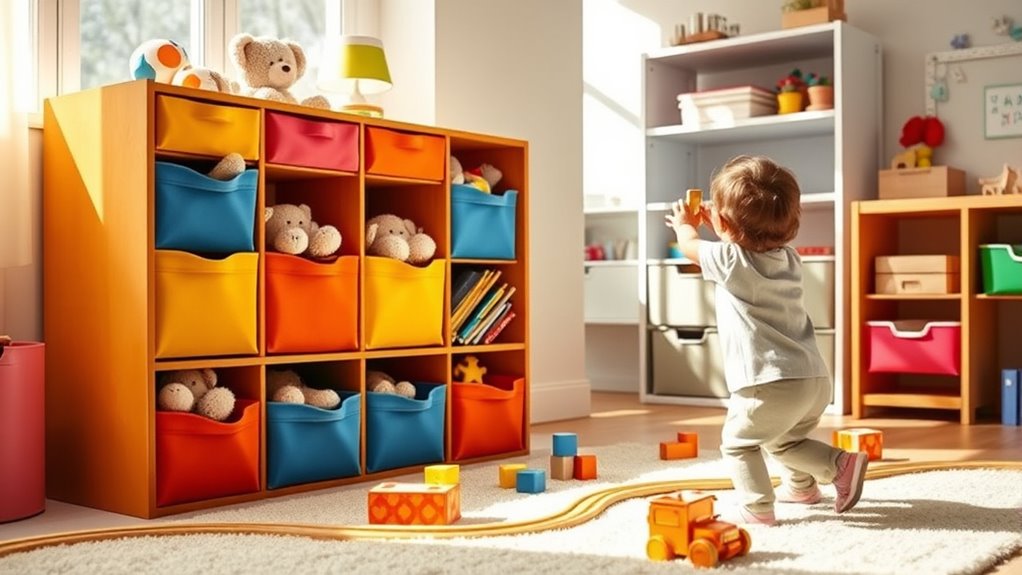
Creative storage solutions not only help organize toys but also provide a fantastic opportunity to engage children in the process. When you involve your kids in toy organization, they develop a sense of ownership and responsibility for their play space.
Here are some effective ways to engage them:
- Teach them to categorize toys by type, enhancing sorting skills.
- Encourage decision-making by asking which toys they use most.
- Foster pride in their play area by celebrating their efforts.
- Instill lifelong habits of tidiness through regular organization sessions. Additionally, consider discussing the importance of long-term financial planning to help them understand the value of keeping their space organized, as it contributes to a well-managed home environment.
Benefits of a Tidy Play Environment

While a tidy play environment may seem like a simple aesthetic choice, it actually brings numerous benefits that enhance both children's development and family dynamics.
A clutter-free space improves your child's focus and creativity, allowing them to engage deeply with their toys and develop problem-solving skills. When toys are organized, your kids will likely take better care of their belongings and learn responsibility.
Plus, a clean play area saves you time managing chaos, letting you enjoy more quality moments together. You'll also benefit from reduced stress, as studies show that a tidy environment promotes mental well-being for everyone. Additionally, a well-organized space encourages mindfulness and emotional well-being, fostering a deeper connection with their surroundings.
Frequently Asked Questions
What Types of Toys Should We Prioritize for Decluttering?
When decluttering toys, prioritize those you've noticed your kids rarely play with.
Focus on broken items, duplicates, or toys that are too advanced for their current age.
Consider sentimental items, too; if they don't spark joy or hold strong memories, it might be time to let go.
Look for toys that serve similar purposes, and keep only the ones your kids actively engage with.
This'll create a more organized and enjoyable play space.
How Can We Involve Younger Children in Organizing Toys?
Involving younger children in organizing toys can be fun and educational.
Start by turning the process into a game—set a timer and challenge them to see how many toys they can sort in that time. Use colorful bins or labels to make it visually appealing.
Encourage them to decide what they want to keep, donate, or toss, giving them a sense of ownership.
Praise their efforts, and soon they'll enjoy tidying up!
Are There Specific Storage Solutions for Small Spaces?
Did you know that 30% of families struggle with clutter due to limited space?
To tackle this, you can use vertical storage solutions like wall shelves or hanging organizers.
Consider multi-functional furniture, such as ottomans with storage inside, to maximize your space.
Clear bins also work wonders; they let you see what's inside while stacking neatly.
With these strategies, you can create a tidy and functional environment in even the smallest areas.
How Often Should We Reassess Our Toy Collection?
You should reassess your toy collection at least twice a year.
This helps you identify toys that are no longer played with or are broken. When you evaluate regularly, you can keep your space organized and guarantee your child only has toys that spark joy and creativity.
Encourage your child to participate in the process, teaching them the value of letting go of items they no longer use or need.
Can We Repurpose Old Toy Storage Containers Creatively?
Imagine staring at those old toy storage containers, wondering if they're destined for the landfill.
What if I told you they can have a second life? You can transform them into creative organizers for your craft supplies or even planters for your garden.
With a little paint and some imagination, those forgotten boxes can become vibrant additions to your home.
Conclusion
Taming toy chaos doesn't have to feel overwhelming. By using the $15 organizer and implementing simple strategies, you can create a tidy play environment that both you and your kids will love. You might worry that your children won't want to part with their toys, but involving them in the process makes it fun and empowering. Remember, a clean space encourages creativity and play, so give these tips a try and enjoy a more organized home together!



